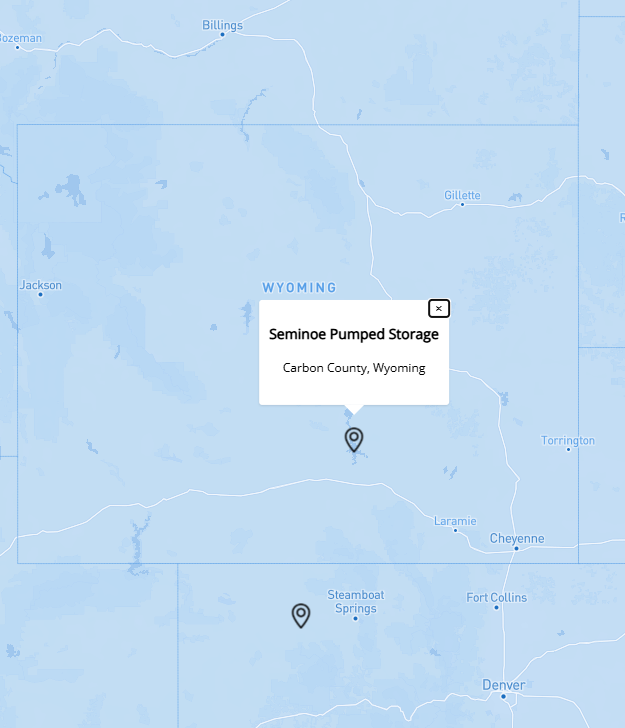The Modern Energy Hub for Wyoming.
Seminoe Pumped Storage Project
The Seminoe Pumped Storage Project is a 900 megawatt pumped hydro energy storage project being developed in Carbon County, Wyoming. This type of system shifts water between an upper reservoir and a lower reservoir to store energy and generate power when needed. In this case, the lower reservoir will be the existing Seminoe Reservoir. The project will bring substantial economic benefits to the local community and will serve as an important element of Wyoming’s modernized and reliable energy infrastructure.
Project Location & Overview
The proposed project site is located thirty-five miles northeast of Rawlins, Wyoming and is currently in the design and permitting phase. The project will consist of one new reservoir, underground tunnels and underground powerhouse, an intake-outlet structure in Seminoe Reservoir, and a new transmission line. The new reservoir will be located approximately 1,000 feet above the Seminoe Reservoir, approximately 10,000 feet east of the Seminoe Dam. Energy for pumping, and power generated by the project, will be delivered through a new, 30-mile transmission line connecting the project with PacifiCorp’s existing Aeolus Substation, near Medicine Bow.
Project developer rPlus Hydro, through project-specific company Black Canyon Hydro, LLC, has carried out detailed feasibility engineering to optimize the project design and has conducted extensive environmental surveys and analyses to meet stringent requirements for licensing and permitting. Studies began in 2019 along with initiation of environmental surveys and community and agency meetings. All community members, landowners and public agencies are encouraged to participate and learn about the project. Stakeholder feedback is important to ensure the best siting of project facilities, utilization of existing corridors where possible, to avoid sensitive or protected areas when feasible, and to limit overall environmental impacts.
Project Schedule
rPlus Hydro has completed a detailed engineering feasibility study for the project and is currently in the permitting phase. Following initial review by agencies, refinements have been made to certain project features. Nearly all environmental studies for the project have been completed and incorporated into a Final License Application (FLA) that rPlus Hydro filed with the Federal Energy Regulatory Commission (FERC) on January 18, 2023. Valuable stakeholder feedback has been collected since the FLA filing, and remaining environmental studies and analyses are underway and scheduled to be completed in 2025. FERC is preparing a Draft Environmental Impact Statement (DEIS) and is expected to issue that document in September 2025. A Final Environmental Impact Statement (FEIS) is expected in 2026.
Construction is expected to begin as early as 2027, pending timely issuance of a FERC license and other approvals, and would take place over approximately four to five years.
How Does Pumped Storage Work?
-
The initial one-time fill requirement is about 10,000 acre-feet. Once operational, the estimated water requirement is less than 300 acre-feet per year.
-
The project is in the planning and design phase and detailed facility dimensions and footprints are being determined. Details will be provided as they become available and will be documented in detailed permit applications. The above-ground land required for the long-term operation of the project is for reservoirs, access roads, parking/staging areas, and transmission line structures. The remainder of facilities will be underground and out of sight.
-
Protecting the natural environment and promoting economic progress for the community is a critical objective for the project. The developer is committed to developing the project responsibly, including minimizing and mitigating impacts. In addition, the project is subject to stringent permitting and licensing requirements under the Federal Energy Regulatory Commission (FERC) and the U.S. Department of Interior, Bureau of Land Management (BLM), Bureau of Reclamation (USBR), as well as other local and state permitting and stakeholder relations. The project will be subject to the National Environmental Policy Act (NEPA) and numerous other federal, state and local requirements. Read more in Project Details and Regulatory section.














